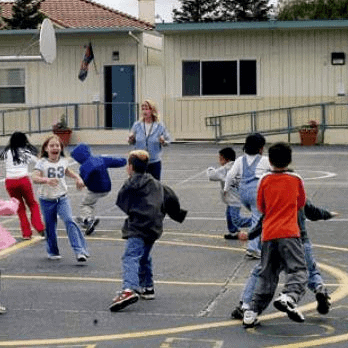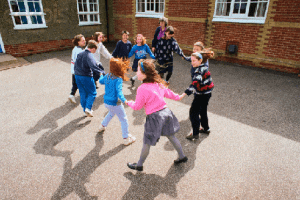The American Academy of Pediatrics Explains Why Recess Should Not Be Withheld

|
Getting your Trinity Audio player ready...
|
Why is Recess Important for Children in School?
Policymakers, educators, and parents often talk about the role of schools in promoting the development of the whole child (e.g., physical, social, and academic development).
A growing trend toward putting more emphasis on academics has put, recess, which promotes physical and social development, at risk.
Recess provides a much-needed, planned break from academics. It allows students to have time to rest, play, imagine, think, socialize, and move. After recess, students are more attentive and better able to perform.
Additionally, safe, well-supervised recess offers cognitive (thinking, reasoning, or remembering), social, emotional, and physical benefits according to research.
Recess also gives children the opportunity to practice and develop social skills, in a way that can’t be provided in the structured classroom environment.
“The American Academy of Pediatrics states that recess is a crucial and necessary component of a child’s development and, therefore, it should not be withheld for punitive or academic reasons.”

Recess is sometimes reduced or taken away at school.
Despite the indications that recess is important and benefits children, recent surveys and studies demonstrate that schools sometimes reduce recess to make more room for academics.
Schools also sometimes take away recess for punitive or behavioral reasons.
Additionally, the period of time given for recess decreases as children get older, and children of lower socioeconomic status or those in urban settings tend to have less recess time.
How is Recess Defined?
The Center for Disease Control and Prevention defines recess as “regularly scheduled periods within the elementary school day for unstructured physical activity and play.”
Cognitive and Academic Benefits of Recess
Children learn naturally through interactive, manipulative experiences, which are found during play in an unstructured social environment like recess.
To be most ready to learn, a child needs a period of interruption after a period of concentrated instruction.
Unstructured breaks are found to be more beneficial than simply shifting from one cognitive task to another.
Research demonstrates that recess, whether provided indoors or outdoors, leads to children being more attentive and productive in the classroom.
This finding was true even in cases where the students spent much of their recess time socializing. In fact, a student’s ability to refocus during class time was shown to be stimulated more by the break from class, than by the mode of activity that occurred during that break.
In other words, any type of activity at recess benefited cognitive performance afterward.
Although the specified time allotted for recess decreases with age, the benefits of periodic breaks in the academic day apply equally to adolescents and younger children.
What are the social and emotional benefits of recess?
Recess promotes natural social-emotional learning and development for children by giving them time to interact with peers, allowing them to practice important social skills.
Allowing socialization, under adult supervision, adds to the learning environment, stretching it outside of the classroom.

While playing at recess, children learn useful communication skills, such as negotiation, cooperation, sharing, and problem-solving.
They also learn coping skills, such as determination and self-control.
These skills are necessary and can last a lifetime.
Recess also offers children a necessary, socially structured means for managing stress by allowing for needed breaks, fun games, exercise, and time with friends.
What are the physical benefits of recess?
There is a vast amount of literature available on the need for and benefits of physical activity and fitness, for a child’s physical well-being and academic and social maturity.
Not all children play vigorously during recess; however, recess does provide children the opportunity to be active in the mode of their choice and to practice movement and motor skills (e.g., running, climbing, jumping).
Even a little movement during recess brings children closer to the recommended “60 minutes of moderate to vigorous activity per day”, a standard supported by the American Academy of Pediatrics (AAP), which can help lower the risk of obesity.
Policy makers and funding organizations have recently called for more opportunities for daily physical activity as a way to address childhood obesity.
This has strengthened the argument to maintain or reinstate recess as an essential part of the school day.
How do we address safety concerns at recess?
Parents, teachers, and administrators have expressed concern for children’s safety during recess.
Some schools have chosen to disallow games or activities deemed unsafe, and in some cases, to discontinue recess entirely because of the many issues connected with child safety.
Although schools should ban games and activities that are a threat to child safety, they should not discontinue recess altogether.
There are steps schools can take to address safety concerns and protect children, while still allowing play during recess.
Compliance with the Consumer Product Safety Commission’s Playground Safety Handbook will help to ensure proper maintenance of playground equipment that meets the following federal guidelines:
1. Provision of adequate safe spaces and facilities.
2. Maintenance of developmentally appropriate equipment with regular inspections.
3. Establishment and enforcement of safety rules.
4. Implementation of recess curriculum in physical education classes to teach games, rules, and conflict resolution.
5. Establishment of a school-wide, clear policy to prevent bullying or aggressive behavior.
6. Provision of adequate supervision by qualified adults who can intervene in the event a child’s physical or emotional safety is in jeopardy.
“Some playgrounds in areas with a high risk of violence may require additional protective measures to ensure the safety of children.”
What should the timing and duration of recess be?
In the United States, the duration and timing of recess periods can vary by age, grade, building and/or school district. Many elementary schools offer recess right after students eat lunch.
Studies show that when recess is given before lunch, students spend more time eating; and less food is wasted. This is why some schools have adopted a recess-before-lunch policy.
Additionally, when recess is offered before lunch, teachers and researchers have found an improvement in student behavior at mealtime, and in the classroom in the afternoon.
“The Centers for Disease Control and Prevention and the US Department of Agriculture support the idea of having recess before lunch as part of a school’s wellness policy.”
Although peer-reviewed research has examined the timing and type of activity during recess and recorded the many benefits of recess for children, an optimal duration has not been identified. However, there is agreement about the need for regularly scheduled recess based on national guidelines.
In schools, the length specified for recess time ranges from 20 to 60 minutes a day.
In some countries, such as Japan, grade school children have a 10- to 15-minute break every hour, due to fact that attention spans begin to diminish after 40 to 50 minutes of intense instruction.
Therefore, to maximize performance, recess should be scheduled at regular intervals, providing children adequate time to regain their focus before instruction continues.
Conclusions About the Importance of Recess in Schools
Even with plenty of evidence regarding the benefits of recess, significant pressures related to standardized testing mandated by educational reforms, have led some to think that recess and physical education would be better spent on academics.
Time previously dedicated to physical education and recess, is being reallocated for additional academic instruction.
Ironically, reducing recess time may be counterproductive to academic achievement, as a growing body of evidence suggests that recess promotes physical health, social development, and cognitive performance.
While recess and physical education both encourage activity and a healthy lifestyle, it is only supervised, unstructured recess that offers children the opportunity to play creatively.
“Pediatricians’ support of recess is an extension of the AAP’s policy statement supporting free play as a fundamental component of a child’s normal growth and development.”
Based on an abundance of scientific studies, withholding recess for punitive or academic reasons would seem to counteract the intended outcome of improving academic performance, and may take away from children’s development of important life skills.
Below is a quote from one of my favorite articles on this topic “The School Keeps Taking Away My Child’s Recess” from adayinourshoes.com.
“The main reason that I hate recess being taken away is the underlying message it sends, which I think is: ‘Look, we know that the rest of your school day is craptastic, and the one escape time that you have to relax is recess, so we’re going to take that from you.’ It inherently tells kids that ‘recess is the most desirable part of the school day.’
Why not send the message that all learning is fun?
It also sends the message that play/recess has no value, and therefore, it doesn’t matter if we take it from you. No harm, no foul.
That couldn’t be further from the truth!”






